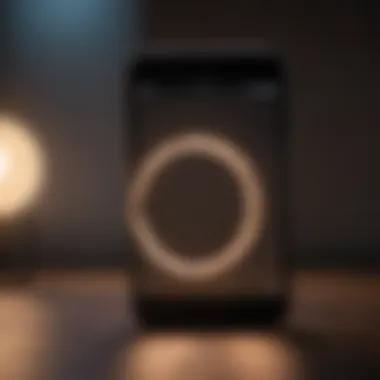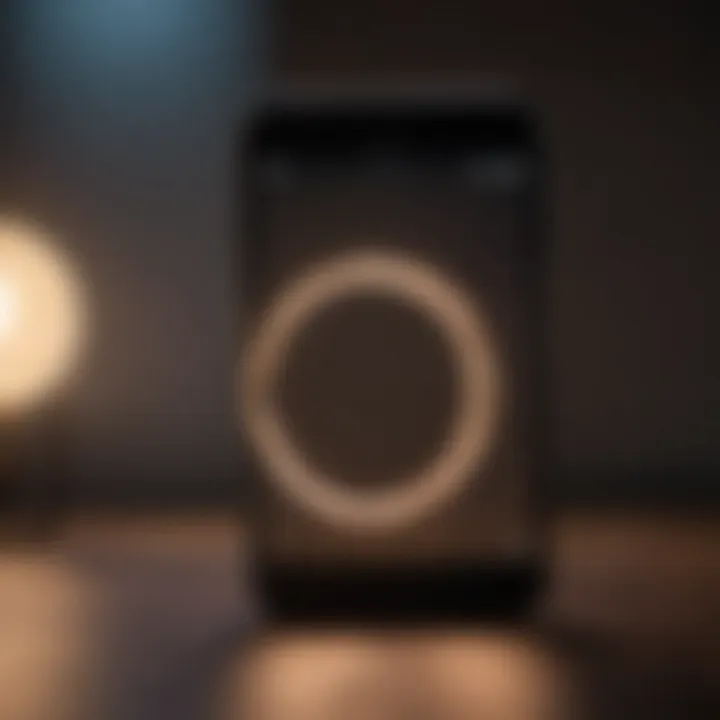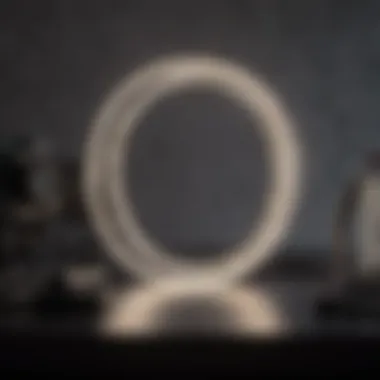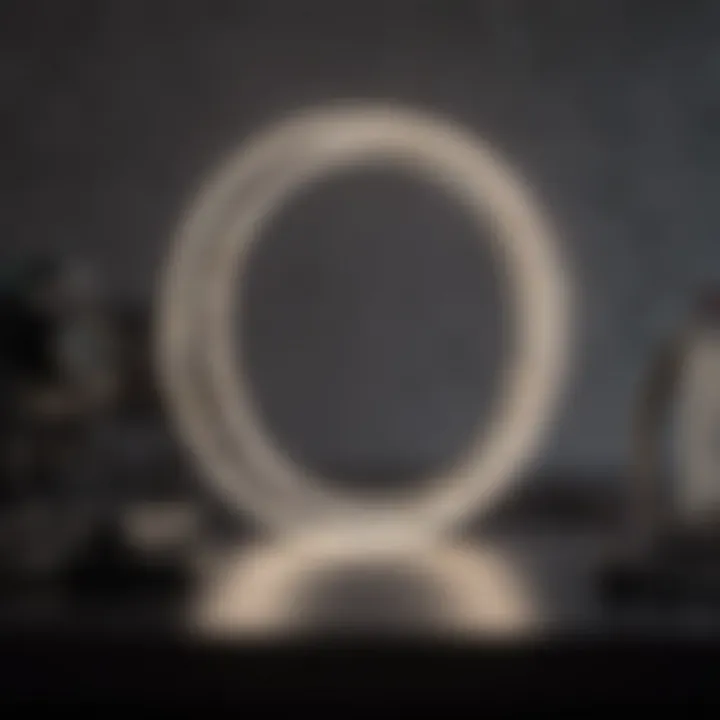Understanding the iPhone Light Flash Ring: A Guide


Intro
The light flash ring on the iPhone is an often overlooked but essential feature that serves a variety of functions. It plays a pivotal role in user notifications, camera capabilities, and accessibility options. Understanding this feature provides users with greater control over their device experience. With evolving iPhone models, the light flash ring's significance and usage have transformed. This article will explore its functionality, potential for customization, and troubleshooting tips, aiming to maximize the utility of this small but impactful feature.
Product Overview
Preamble to the Apple product being discussed
The iPhone, Apple's flagship smartphone, seamlessly integrates innovative technology with user-friendly design. The light flash ring, located around the rear camera lens, serves as a versatile tool.
Key features and specifications
This feature acts as a flash for photographs, enhancing low-light image capturing. It also serves as a visual notification indicator, particularly useful for users who may not hear the phone's alerts. Its design complements the sleek aesthetics of the iPhone, adding to its overall appeal.
Design and aesthetics
The light flash ring is crafted with precision. Typically encircled by refined metal or glossy glass, it adds an element of sophistication to the camera cluster. The integration of this functionality within the design is notable.
Performance and User Experience
Performance benchmarks
The light flash ring operates flawlessly, triggering instantaneously to enhance photo quality. When utilized for notifications, its brightness and responsiveness are generally consistent across various iPhone models.
User interface and software capabilities
Apple's iOS provides intuitive controls for managing the light flash ring settings. Users can customize when and how the light flashes based on their preferences, enhancing overall usability.
User experiences and feedback
Many users appreciate the dual functionality of the light flash ring. Those with hearing impairments report it as a valuable feature in notifications. Feedback consistently highlights its reliability, making it an integral part of iPhone usability.
Tips and Tricks
How-to guides and tutorials for optimizing the Apple product's performance
To make the most out of the light flash ring, ensure your notifications are configured properly. For example, accessing Settings > Accessibility > Audio/Visual allows users to customize the flash for alerts.
Hidden features and functionalities
The light flash ring can be set to flash for various notifications, including calls, messages, and app alerts. This customization can be set through the same Accessibility settings.
Troubleshooting common issues
If the light flash ring is not functioning correctly, check the Accessibility settings. Ensure that the toggle for 'LED Flash for Alerts' is turned on. Restarting the device can also solve minor glitches.
Latest Updates and News
Recent developments in software updates and new features
Apple frequently releases software updates that may enhance features associated with the light flash ring. Staying updated is advisable for optimal performance.
Industry news and rumors surrounding upcoming products
As Apple continues to innovate, speculations often arise regarding future models and their features. Engaging sources like reddit.com or en.wikipedia.org can provide insights into upcoming changes.
Events and announcements from Apple
Apple regularly announces updates and new releases during events throughout the year. Following these events can provide the latest news about features related to the light flash ring.
Understanding the light flash ring offers a clearer comprehension of its role in enhancing the iPhone experience. Through customization and proper setting management, users can significantly improve their overall device usability.
Prelims to Light Flash Ring on iPhone
The light flash ring on the iPhone is more than just a design feature. It has significant implications for functionality and user experience. Understanding this element is important for users looking to enhance their interactions with their devices. Notably, the light flash ring serves various purposes, including as a notification system and an aid for photography. By exploring the light flash ring, users can leverage its full potential, thereby improving the overall usability of their devices.


Definition and Purpose
The light flash ring is a component surrounding the camera lens on iPhones. Its primary purpose is to provide illumination when the camera is activated, particularly in low-light conditions. This feature is meant to enhance image quality by ensuring sufficient lighting. Additionally, the light flash ring also functions as a notification alert. For incoming calls or messages, it can emit light bursts, providing an alternative to auditory alerts. This is especially useful in quiet environments or for users with hearing difficulties. Thus, its dual functionality solidifies its importance in everyday phone use.
Historical Context
The concept of a camera flash is not new, but its evolution has significantly changed how smartphones use this technology. Initially designed for standalone cameras, flash technology has integrated into mobile devices over the years. The iPhone introduced the light flash ring as part of a more comprehensive approach to photography and notification systems. Apple's innovative design allowed users to experience superior photo quality alongside improved call and message alerts. As smartphones have become essential tools in daily life, features like the light flash ring have evolved to meet user expectations for quality and convenience.
Technical Specifications
Understanding the technical specifications of the light flash ring is crucial for users who want to maximize their iPhone experience. This section explores the design and function intricacies, offering insight into how each aspect contributes to the overall effectiveness of this feature.
Design and Placement
The design of the light flash ring on the iPhone is both practical and aesthetic. Positioned around the camera lens, it serves a dual purpose: enhancing photography and acting as a notification alert. The circular shape is not just visually appealing; it ensures the light is evenly distributed. This placement is strategic, as it allows the flash to synchronize seamlessly with the camera's functions. Understanding its layout helps users see how the device integrates multiple functionalities into a single component.
Additionally, the material used for the flash ring is significant. Usually, a durable plastic or glass is used to protect the internal components. This durability is essential, given the frequent use of the flash in various conditions. The surrounding area is often designed to minimize the chance of reflections, allowing for better performance in both low light and bright environments.
Light Technology Used
The light technology employed in the iPhone's flash ring has evolved over the years. Early models relied on basic LED lights, but as technology advanced, so did the options available. Currently, most iPhone models use advanced LED technology which offers better brightness and color accuracy compared to traditional incandescent bulbs. This leads to improved image quality and more natural skin tones in photos, making it sensitive to various lighting conditions.
Moreover, the light emitted can be modulated to suit specific tasks. The ability to switch between different levels of intensity allows users to customize their experience. For instance, in photography, a softer light can be used to reduce harsh shadows, enhancing portraits significantly. In contrast, brighter settings can be necessary for activities like video recording, where clarity is paramount.
"Continuous advancements in LED technology enhance the flexibility and functionality of the light flash ring, making it a versatile tool for users."
Understanding the underlying technology not only aids users in making better use of their device but also places them in a good position to evaluate future changes in iPhone models. As Apple continually refines its technology, awareness of these specifications will help users appreciate the ongoing improvements.
Functions of the Light Flash Ring
The light flash ring on the iPhone is not merely a design element; it plays a crucial role in enhancing the overall user experience. Understanding the various functions of the light flash ring illuminates its significance in day-to-day usage. This section focuses on three primary functions: notification alerts, camera flash support, and video recording enhancements. Each function offers unique advantages, making the light flash ring a valuable feature for a wide range of users.
Notification Alerts
The light flash ring acts as a visual alert mechanism, offering an alternative to audible notifications. This feature is particularly useful in environments where sound is not practical, such as meetings or quiet places. The light flash ring enables users to remain aware of incoming notifications without drawing undue attention to themselves.
This functionality serves various purposes:
- Visual Cues: Flashing lights provide immediate visual feedback for texts, calls, and app notifications.
- Accessibility: For individuals with hearing impairments, the light flash ring becomes an essential tool to stay updated.
- Customization Options: Users can modify the settings to adjust the frequency and pattern of the flashes, catering to personal preferences.
Through these features, the light flash ring enhances how users interact with notifications, making it a practical solution for various situations.
Camera Flash Support
In addition to notifications, the light flash ring plays a pivotal role in photography. When taking pictures, it serves as a supplementary flash, ensuring that images are well-lit even in low-light conditions.
The benefits of the light flash ring in camera usage include:
- Better Image Quality: The ring provides an even distribution of light, reducing harsh shadows that can occur with traditional camera flashes.
- Real-Time Feedback: The flash ring activates just before the shutter release, allowing users to gauge lighting conditions instantly.
- Versatility: It is especially beneficial for selfies and group shots, where lighting can vary significantly.
This added support not only improves photo quality but also makes the photography experience more enjoyable for users.
Video Recording Enhancements
Video recording has become increasingly popular with the rise of social media and virtual communications. The light flash ring contributes to this functionality by enhancing the lighting during video capture.
Here’s how it enhances video recording:
- Illumination: The ring provides supplementary light for clearer and brighter videos.
- Focus on Subjects: It aids in highlighting subjects, ensuring they are well-lit against darker backgrounds, leading to professional-looking recordings.
Overall, the light flash ring is a multifaceted tool that extends beyond simple alerts. It is integrated into several features that contribute significantly to users' daily experiences with their iPhones.
Customizing the Light Flash Ring
Customizing the light flash ring on an iPhone is a salient aspect of enhancing its functionality and personalizing user experience. The light flash ring can serve several purposes depending on how the user chooses to configure it. By tailoring settings to individual preferences, users are empowered to optimize notifications, camera settings, and overall accessibility. This section delves into the specifics of customizing the light flash ring, highlighting the benefits and considerations that come with this feature.


Accessing Settings
To begin customizing the light flash ring, users must first access the settings menu on their iPhone. This is done by locating the ‘Settings’ application, a common hub for adjusting various device settings. Once in the settings menu, follow these steps:
- Scroll down and find the option titled Accessibility.
- Tap on Audio/Visual.
- Look for the section labeled LED Flash for Alerts.
This setting controls how the light flash ring responds to notifications and alerts. By enabling this feature, users have the ability to receive visual alerts, which can be particularly useful in noisy environments or for those with hearing impairments.
Adjusting Brightness
Adjusting the brightness of the light flash ring is critical for ensuring visibility while also conserving battery life. Users can modify the brightness settings through the main Display & Brightness section found within the Settings app. This adjustment can impact not only the light flash ring but also the overall display. Here’s how to adjust the brightness:
- In Settings, select Display & Brightness.
- Use the slider to increase or decrease the brightness level according to your preference.
It is advisable to keep the brightness at a level that is noticeable without being overly distracting, especially in dim environments. A moderate setting allows for an effective alert system without overwhelming users with brightness.
Setting Flash Patterns
Another key customization option is setting specific flash patterns for notifications. This feature can be useful for distinguishing between different types of alerts. For example, users might prefer a quick double flash for text messages and a longer flash for critical alerts. However, it should be noted that this functionality may not be available on all iPhone models or iOS versions.
To customize flash patterns, follow these instructions:
- Open Settings and navigate to Accessibility.
- Tap on Audio/Visual.
- Under LED Flash for Alerts, look for options to enable flash on silent mode.
While iPhones do not offer extensive built-in options for creating varied flash patterns, third-party applications might provide further customization. Users keen on enhancing their experience can explore apps that optimize alert systems to suit their preferences.
In summary, customizing the light flash ring is a practical effort that enhances its utility. By accessing settings, adjusting brightness, and exploring flash patterns, users can streamline the way they interact with their device. This not only augments the experience but also addresses individual needs, making it essential to familiarize oneself with these settings for an enriched iPhone experience.
Light Flash Ring and Accessibility
The Light Flash Ring on iPhone is not just an aesthetic feature; it serves vital functions that cater to various accessibility needs. Understanding its implications for users with different abilities highlights the technology's thoughtful design. This section explores how the light flash ring enhances communication for the hearing impaired and offers customization options beneficial for visually impaired users.
Enhanced Notification for Hearing Impaired
For many users, the auditory notifications from their devices can be missed, especially in noisy environments. The Light Flash Ring addresses this issue by providing a visible alternative to sound alerts. Rather than relying solely on audio signals, users who are hearing impaired can utilize the flash ring to receive important notifications. This feature is significant during calls, messages, or app alerts, as the visual feedback ensures that alerts are noticed.
- Increased Visibility: The flash is bright and obvious, making it easier to see even from a distance.
- Customizable Settings: Users can configure their devices to flash in different patterns for various types of notifications. This helps in distinguishing between messages and calls.
- Reduced Anxiety: For individuals who may feel uncertain about missing notifications, the light flash ring can provide reassurance and confirmation.
"The integration of visual notifications significantly enhances usability for individuals with hearing loss, ensuring they remain connected in their daily lives."
Customizing Alerts for Users with Visual Impairments
Customizing alert settings using the light flash ring can also offer substantial advantages for users with visual impairments. This approach helps create a more inclusive environment by tailoring alert systems to meet individual needs. Users can adjust how their devices communicate notifications, using the flash ring as a tool for effective interaction.
- Distinct Flash Patterns: Users can create different flash patterns that correlate with specific alerts. For example, a quick double flash for messages could mean different urgency than a sustained flash for events.
- Brightness Adjustment: The brightness of the flash can be modified, which is helpful for different lighting environments and individual comfort levels.
- Tactile Feedback Options: Using haptic feedback in conjunction with the light flash ring can create a comprehensive notification system. This dual approach ensures that users receive multiple cues about alerts that are important.
Overall, the light flash ring's accessibility features represent Apple's commitment to inclusivity. By allowing users to customize their experiences, Apple makes technology more accessible to a broader audience.
Troubleshooting Light Flash Ring Issues
The light flash ring on the iPhone provides important functionalities, but sometimes it does not work as expected. Troubleshooting these issues can enhance user experience. Understanding common problems can save time and reduce frustration. It can also increase overall satisfaction with the device. Fixing issues can lead to a more reliable notification system, improving communication.
Common Problems Encountered
There are several issues users may face related to the light flash ring. Some problems include:
- Inconsistent Flashing: The light may not flash consistently when notifications arrive.
- Inability to Customize Settings: Users might find that settings changes are not reflected on the device.
- Flash Ring not activating during Calls: The light may fail to activate during incoming calls despite proper settings.
- Limited Visibility: In bright environments, the flash may be too dim, and thus not noticeable.
These problems can stem from software bugs, incorrect settings, or even hardware issues. Identifying the root cause is the first step toward resolution.
Steps for Resolution
Once the issues are identified, there are several steps users can take to resolve them. Here are some recommended actions:
- Check Settings: Navigate to Settings > Accessibility > Audio/Visual and ensure that LED Flash for Alerts is enabled. This is a common oversight.
- Restart the Device: A simple restart can fix many minor software glitches that prevent the light from functioning properly.
- Update iOS: Make sure the device is running the latest version of iOS. Updates often fix bugs and enhance functionality.
- Reset Settings: If issues persist, resetting all settings might be the answer. Go to Settings > General > Reset > Reset All Settings. This will not delete data but revert configurations to default.
- Consult Apple Support: If none of the above steps work, it could be a hardware issue. Contacting Apple Support may provide options for repair or further assistance.


Remember: Always back up important data before making significant changes to device settings.
By following these steps, users can resolve common issues with the light flash ring on their iPhones effectively.
Comparative Analysis
The comparative analysis of the light flash ring on iPhone against similar features in other smartphones is crucial for understanding its unique position in the market. This examination allows users to assess the effectiveness and adaptability of this feature in real-world applications. Notably, by comparing the design, functionality, and user preferences, we highlight the advantages and limitations of the light flash ring. Moreover, such an analysis aids in informed decision-making for potential buyers and enhances user appreciation for the technology they use daily.
iPhone vs. Other Smartphones
When contrasting the iPhone’s light flash ring with that of other smartphones, several factors arise. For instance, many Android devices offer similar notification light systems. However, the implementation varies widely among brands such as Samsung and Google.
- Design Choices: While iPhones have a consistent flash ring design across models, other brands may feature a multi-color LED option. This versatility can appeal to those who prefer visual variety.
- Integration with Notification System: iPhone’s light flash ring integrates seamlessly with its operating system, making notifications highly noticeable. In other devices, users might find inconsistencies in the notification patterns or require additional configuration, which can detract from user experience.
- Camera Support: The camera flash support in iPhones is optimized, providing better illumination compared to many competitor products. This efficiency enhances photography quality, particularly in low-light conditions.
Ultimately, the iPhone’s light flash ring is designed for both aesthetics and functionality. Users of Android devices might argue for more customization, but the iPhone often provides a more reliable experience.
User Preference Trends
User preferences regarding device features reveal essential insights into the effectiveness of the light flash ring. Surveys and usage statistics from forums like Reddit display distinct trends in how consumers utilize notification systems.
- Preference for Simplicity: Many users favor the straightforward approach iPhones take with their light flash ring. A simpler notification system often leads to fewer distractions, aligning with contemporary demands for minimalism in tech.
- Demand for Versatility: Despite the preference for simplicity, there is an evident demand for customizable features. Users want to distinguish different types of notifications without cluttering their screens. Some prefer colored notifications, which are prevalent in other smartphone brands.
- Accessibility Considerations: Users with hearing impairments highlight the importance of visual notifications. iPhone's light flash ring specifically enhances their experience, indicating a growing user expectation for accessibility.
In summary, while the preferences vary widely among users, the iPhone's light flash ring stands out for its fusion of practicality and design, catering particularly well to many tech enthusiasts and professionals in the industry.
Future of the Light Flash Ring Technology
The light flash ring feature within iPhones has evolved significantly since its inception. Its future is poised for further advancements, promising an even richer user experience. Understanding the direction this technology is headed is essential for users who rely on it for notifications and accessibility. This section explores potential innovations and user applications in the coming years.
Innovations on the Horizon
Several innovations are likely to emerge in the realm of light flash ring technology. One key area is improved integration with augmented reality (AR) applications. As AR becomes more prominent, the light flash ring could serve as a visual cue within various applications, enhancing user interaction.
Another anticipated development is the implementation of adaptive lighting. This means the light’s intensity and color could adjust based on the environment. For example, in a bright outdoor setting, the flash might become more vivid to ensure visibility. User preferences will also play a crucial role, allowing people to customize their light flash settings according to their needs.
Security features may also see enhancements. The flash ring could signal alerts during emergencies or notifications from security apps. Such advancements could provide peace of mind for users, further increasing the ring's utility.
Potential User Applications
As technology advances, the applications for the light flash ring will expand. One primary area is in smart home integration. As users increasingly rely on smart home devices, the light flash ring may work in conjunction with these systems to provide real-time alerts. For instance, if a doorbell camera detects motion, the light could provide a visual indication on the iPhone.
Health and wellness applications are another promising avenue. The flash could be used in conjunction with health tracking apps, alerting users to reminders for medication or exercise breaks. This feature could enhance health management for those who depend on their devices for regular tracking.
Additionally, in education and productivity, the light flash ring can serve notification roles for important reminders during meetings or class sessions. This functionality could prevent distractions from sound and offer a subtle way to stay informed.
Overall, the light flash ring is set to transform with technology. With innovative applications on the horizon, users will find even greater utility and convenience.
"Staying at the forefront of mobile technology demands attention to evolving features, such as the light flash ring, which enhance user interaction and engagement."
Emphasizing on the future of the light flash ring indicates a clear shift towards adaptive and context-aware technology, aligning with broader trends in digital functionalities. The journey ahead will likely bring further improvements that cater to the diverse needs of iPhone users.
End
The conclusion serves as a pivotal section in this article, encapsulating the wealth of information presented regarding the light flash ring on the iPhone. It is crucial to acknowledge how this feature integrates into daily usage and enhances the overall user experience. The light flash ring not only alerts users to notifications but also supports functional aspects like photography and accessibility, making it a valuable tool in the iPhone ecosystem.
In summarizing the key elements explored, readers comprehend the practical applications of the light flash ring and its significance in notification management. Additionally, understanding how to customize and troubleshoot this feature empowers users with greater control over their devices. This knowledge ultimately fosters a more personalized experience, catering to individual preferences.
- Enhancements: By recognizing how the light flash ring can be tailored, users can improve their engagement with their devices.
- Considerations: Thoughtful customization could lead to better notice of incoming communications, especially for those with varying sensory capabilities.
- Implications: The discussion around accessibility showcases a commitment to inclusivity in tech, urging manufacturers to consider all users.
"Understanding features like the light flash ring contributes to maximizing the potential of devices, leading to more informed user choices."
Recap of Key Points
The discussions throughout this article highlight the numerous functionalities and benefits that the light flash ring offers. Key points include:
- Definition and Purpose: Understanding its basic functional premise and historical development.
- Technical Specifications: Detailed specifications regarding design and the underlying technology at play.
- Functions: Diverse applications, from notifications to enhancing photographs and videos.
- Customization: Insights on adjusting settings to suit personal user preferences.
- Accessibility Features: How the flash ring plays a role in supporting hearing and visual impairments.
- Troubleshooting: Strategies for diagnosing and fixing common issues.
- Comparative Analysis: The differences and preferences between the iPhone light flash ring and equivalent features on other devices.
- Future Technologies: Anticipated advancements and potential applications, emphasizing the importance of this feature in modern tech.
Final Thoughts on the Light Flash Ring
In closing, the light flash ring on iPhone stands as more than just a flashy accessory; it represents an intricate blend of technology and user-centered design. It facilitates prompt alerts and serves practical roles in photography and accessibility. As technology evolves, so too will the light flash ring, potentially incorporating more advanced features that adapt to changing user needs.
It is vital for users to not only grasp the basic functionalities but also explore the full scope of customization options available. This feature highlights a commitment to enhancing the user experience, ensuring that devices like the iPhone remain relevant and useful in a fast-paced technological landscape. Understanding this element equips users to fully harness the capabilities of their devices, allowing for a richer interaction with technology.



